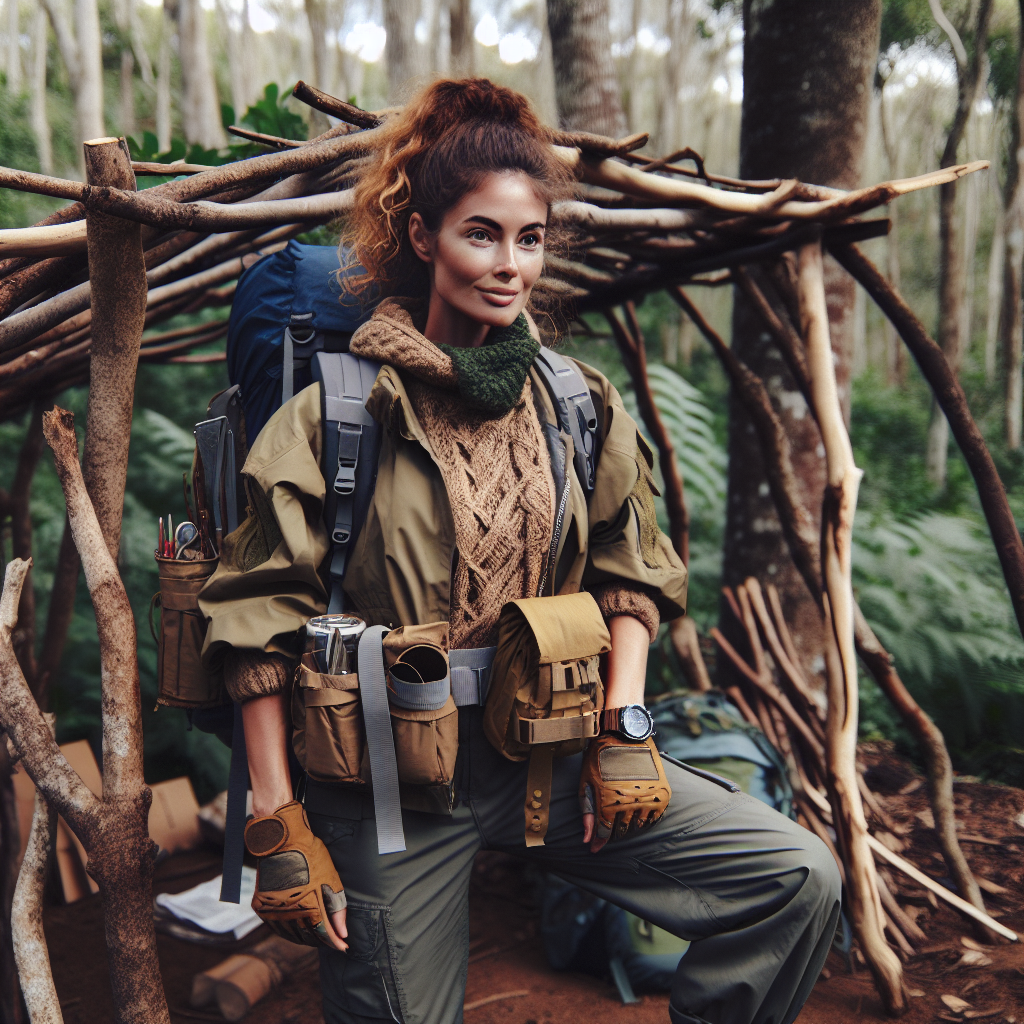Womens Preparedness
Stay Safe and Prepared: Advanced Planning for Natural Disasters

Stay Safe and Prepared: Advanced Planning for Natural Disasters
Hello, ladies! I’m Jade Tripp, and today we’re diving into a topic that hits close to home for all of us—natural disasters. With the increasing unpredictability of weather patterns and environmental changes, being prepared is more crucial than ever. Let’s explore how we can stay safe and ready for whatever nature throws our way, especially in a world where being proactive is the best form of self-defense.
Understanding the Risks
Before we get into planning, it’s essential to understand the types of natural disasters that can happen in your area. For instance, if you’re living in California, wildfires may be a considerable concern. Meanwhile, those in the Midwest should be aware of tornadoes, and residents in coastal regions need to be prepared for hurricanes. Knowing the specific risks can significantly improve your planning efforts.
Real-Life Example: Hurricane Katrina
Let’s talk about Hurricane Katrina, one of the most devastating natural disasters in U.S. history. Many people were caught unprepared, leading to dire consequences. However, communities around New Orleans came together to support each other, showcasing the power of preparedness and solidarity. From this disaster, we can learn valuable lessons on developing our own preparedness plans.
Create Your Emergency Plan
-
Family Communication Plan: Ensure everyone in your household knows what to do in case of an emergency. Choose a family meeting point where you can regroup if separated. Assign roles—who grabs the emergency kit, who’ll check on pets, etc.
-
Evacuation Routes: Familiarize yourself with multiple evacuation routes from your home and workplace. You might find yourself needing to change plans quickly. Apps like Waze can help you find the safest paths in real-time.
- Know Your Community Resources: Identify local shelters, hospitals, and emergency services. Many communities have disaster response teams that you can connect with for support.
Build an Emergency Kit
Creating an emergency kit is as important as having a solid plan. Here’s what to include:
- Water and Non-perishable Food: Aim for at least a three-day supply per person. Think energy bars, canned goods, and dried fruit.
- First Aid Kit: Include essentials such as bandages, antiseptics, and any personal medications.
- Flashlight and Batteries: A quality flashlight can illuminate dark spaces and signal for help if needed.
- Personal Hygiene Products: Don’t forget about wipes, hand sanitizer, and toilet paper!
- Important Documents: Keep copies of identification, insurance policies, and medical records in a waterproof bag.
Real-Life Example: The 2016 Flood in Louisiana
In 2016, Louisiana was hit by severe floods, displacing thousands of residents. Many were underprepared, but those who had emergency kits were better equipped to face the aftermath. This example highlights the importance of not just having a plan, but also possessing the necessary supplies to execute it effectively.
Stay Informed
Knowledge is power! Invest time in staying updated about weather conditions, disaster preparedness tips, and local emergency alerts. Here are some useful resources:
- FEMA App: This app provides real-time information and tips for various disasters.
- Local News Stations: Always check your local news channels during severe weather seasons.
Community Involvement
There’s strength in numbers. Engage with your community by:
- Joining or Starting a Neighborhood Watch: Collaborate with your neighbors to establish a local disaster response team.
- Taking Self-Defense Classes: Not just for personal safety but also to build confidence in emergency situations.
Real-Life Example: Community Resilience in Japan
After the 2011 earthquake and tsunami, Japan focused heavily on community resilience. They implemented extensive disaster drills and encouraged neighbors to form networks for support. Such initiatives have not only saved lives but also strengthened community bonds.
Mental Preparedness
Finally, let’s talk about emotional readiness. Natural disasters can be traumatizing. It’s essential to:
- Practice Mindfulness: Techniques like deep breathing or meditation can help manage stress during crises.
- Seek Support: Don’t hesitate to reach out to friends, family, or counselors to talk about your feelings and fears.
Conclusion: Empowering Ourselves
Preparation for natural disasters is not just about gathering supplies—it’s about empowering ourselves and our communities. By taking these steps, we can create a safety net that supports us through challenging times. Remember, while we can’t control nature, we can control how we respond.
So let’s take these lessons to heart and commit to being proactive. Together, we can foster a culture of safety and resilience—for ourselves, our families, and our communities. Stay strong, stay safe, and let’s prepare for anything that comes our way!
Womens Preparedness
Empowering Women with Essential Outdoor Survival Shelters

Empowering Women with Essential Outdoor Survival Shelters
Hello, fierce warriors! I’m Jade Tripp, and today, we’re diving into a subject close to my heart: outdoor survival shelters. As women, it’s crucial that we equip ourselves not just with knowledge, but also with the skills that empower us in various situations, especially when it comes to self-defense and preparedness in the great outdoors.
Whether you’re a weekend camper, an adventurous hiker, or simply someone who loves the beauty of nature, understanding how to create a survival shelter can be a game-changer. Let’s explore the essentials together!
Why Outdoor Survival Shelters Matter
Outdoor survival shelters can be a lifeline in emergencies, but they also instill a sense of confidence and independence in each of us. Picture this: You’re on a solo hike in the Appalachian Trail, and suddenly, the weather takes a turn, or you miscalculate your return time. Having the know-how to construct a reliable shelter could mean the difference between discomfort and safety.
Essential Types of Shelters
Let’s break down some fundamental shelter types that every woman should be familiar with:
-
Lean-To Shelter
- What is it? A simple structure that can be set up against a fallen tree or rock face, leaning against the support for a sturdy base.
- How to Build It: Start by finding two strong supports. Lay smaller branches against them at an angle, creating a roof. Use leaves, pine boughs, or any available debris for insulation and to protect you from rain.
- Real-Life Example: Sarah McLachlan, a singer-songwriter and humanitarian, once spoke about a camping trip where she had to use a lean-to shelter during an unexpected storm. She was able to stay dry and safe, allowing her to continue her journey with confidence.
-
Debris Hut
- What is it? A natural shelter made from available materials, such as branches and leaves.
- How to Build It: Create a framework with a strong central pole and lean smaller branches against it to form a roof. Pack as much debris (leaves, grass, etc.) onto the roof to provide insulation.
- Inspiration: Consider the survival story of Kelly McGonigal, psychologist and author, who found herself lost in the wild and had to build a debris hut. With determination and a little knowledge, she survived overnight until help arrived.
- Tarp Shelter
- What is it? A versatile shelter made using a waterproof tarp.
- How to Build It: Use ropes to create a high point, then drape the tarp down to the ground. This creates a protection from rain on one side while keeping airflow on the other.
- Community Tip: Many outdoor enthusiast groups, like REI workshops, offer classes on using tarps effectively. These can be fantastic places to learn among women with shared interests!
Gear That Supports Your Shelter-Building Endeavors
Having the right gear can enhance your outdoor experiences and ensure you are prepared in case you need to construct a shelter:
- Multi-tool: This handy device can assist in gathering materials and making necessary adjustments to your shelter.
- Rope/Paracord: Strong and lightweight, it’s essential for securing materials together.
- Emergency Blanket: Lightweight and compact, it can retain body heat or serve as an additional layer for insulation in your shelter.
The Importance of Practice
Just like any skill, practice is key. Create a fun outdoor day with your friends or fellow women adventurers where you simulate building shelters. It’s not just about learning, but also bonding and empowering each other.
In fact, the Women’s Wilderness Institute offers excellent programs that cater to women eager to learn outdoor skills, including shelter building! By participating, you not only sharpen your techniques but also build a community of supportive, empowered women.
Confidence Through Knowledge
Understanding how to construct outdoor shelters is not just a survival skill; it’s about embracing confidence, independence, and empowerment. The wilderness can be unpredictable, but with the right knowledge, we can tackle it head-on.
Remember, every expert was once a beginner. When you gather with other women, share stories, and support each other, you’re creating an unbreakable sisterhood united in strength.
So, let’s empower each other by learning, growing, and preparing for whatever adventures life throws our way. Together, we can conquer the world—one shelter at a time!
Happy adventuring, ladies! 🌲💪
Womens Preparedness
Birth preparedness talk with Midwife Glory.
Womens Preparedness
Women Strong: The Growing Trend of Female Survivalism

Hello, fierce ladies! I’m Jade Tripp, and I’m here to shine a spotlight on a movement that’s not just growing—it’s thriving. Female survivalism is not just a trend; it’s a powerful demonstration of women taking control of their safety, preparedness, and autonomy. As more women recognize their strength and ability to take charge of their personal security, we’re seeing a burgeoning community dedicated to survival skills, self-defense, and self-sufficiency. Let’s dive into this empowering journey together!
The Roots of Female Survivalism
Historically, survivalism was often seen as a male-dominated field, characterized by rugged wilderness survival skills, stockpiling supplies, and prepping for worst-case scenarios. But thanks to trailblazers like Linda Hamilton, who portrayed the fierce Sarah Connor in the "Terminator" series, and inspiring authors like survival expert Linda S. Hurst, women have begun to stake their claim in this realm.
Take, for example, Kaitlyn H., a mother and nurse from rural Colorado. When she became a single parent, she felt an urgency to learn how to prepare her family for uncertainties. With determination, she took courses in first aid, food preservation, and self-defense. Kaitlyn has since transformed her backyard into a mini farm, growing vegetables and raising chickens. Not only has she empowered herself, but she’s also become a mentor to other women in her community. From one woman’s journey, an entire network of resilience blooms!
Why Every Woman Should Embrace Survival Skills
1. Personal Safety
Whether it’s a walk in a busy city or a solo hike in the woods, every woman must prioritize personal safety. Learning self-defense techniques can shift your mindset from victim to warrior. Programs like Girls on Guard in New York City teach practical self-defense mixed with confidence-building exercises. Reports show that women who take such courses feel less anxious and more empowered in their day-to-day lives.
2. Emergency Preparedness
Let’s face it; life can throw unexpected challenges our way, from natural disasters to economic shifts. Knowing how to prepare can make all the difference. In 2020, during the pandemic, many women experienced panic over grocery shortages and supply chains. This prompted women like Leah H., who lives in coastal Florida and frequently faces hurricanes, to establish a systematic prep plan for her family. From stockpiling non-perishable foods to creating a first-aid kit, Leah has effectively turned her household into a haven of preparedness—showcasing that planning ahead fosters both peace of mind and stability.
3. Community Building
Emergency preparedness isn’t just about individual skills; it’s also about community. Women are stepping up to facilitate workshops, exchange knowledge, and build networks of support. Groups like "Ladies’ Survival Group" on Facebook bring women together to discuss topics ranging from outdoor skills to self-defense workshops, fostering connections that empower each participant. Just ask Melissa, who initially felt overwhelmed starting her own herb garden; through her local women’s group, she not only gained gardening tips but also a close-knit circle of friends who share her passion.
Real-Life Impact: Women Triumphing in Tough Situations
Real stories of women demonstrating incredible survival skills dot our history and present-day narratives:
-
Jessica Meir: NASA astronaut Jessica Meir has become a role model for many women. Not only did she participate in spacewalks, but during her training, she learned survival skills including wilderness navigation and emergency medical techniques—skills she hadn’t imagined she would need until her missions required quick thinking and adaptability.
- Lynsey Addario: A war photographer and journalist, Lynsey has often found herself in perilous situations in conflict zones. Her firsthand experiences emphasize the importance of self-defense training and situational awareness in environments that are often unpredictable. Her story shows women that awareness can be a powerful tool in any scenario.
Getting Started on Your Journey
Feeling inspired? To jumpstart your own survivalist journey, start with these steps:
-
Self-Defense Classes: Seek out local classes or online resources that teach practical techniques. Organizations like "Defensive Arts" offer courses tailored for women.
-
Join Community Groups: Look for local women’s groups focused on survival skills, preparedness, or outdoor activities. Platforms like Meetup and Facebook are excellent resources.
-
Education: Read books on survival skills, such as "The Ultimate Guide to Wilderness Living" by John McPherson, or join online courses that focus on personal safety and emergency preparedness.
- Practice: Incorporate skills into your daily routine. Whether it’s practicing self-defense moves or creating an emergency kit, taking small steps each day builds your confidence and resilience.
Conclusion
The trend of female survivalism is powerful. It’s a celebration of strength, independence, and resilience. As women, we are capable of so much more than society often gives us credit for. Let’s harness that potential and immerse ourselves in the world of preparedness. Together, we can foster a movement where every woman feels empowered to face life head-on, ready for any challenge that comes her way.
Remember, ladies, our strength lies not just in our ability to survive but in our determination to thrive. Let’s embrace our journeys with courage and pride! 💪🌿
-

 Womens Self Defense11 months ago
Womens Self Defense11 months agoNew Legislation Empowers Women to Defend Themselves
-

 Self Defense News1 year ago
Self Defense News1 year agoShe was convicted of killing her abusive boyfriend. Now a Maple Grove woman is home awaiting a new trial.
-

 Self Defense News1 year ago
Self Defense News1 year agoSelf-Defense for All: The new Gracie Jiu-Jitsu Pasadena is for everyone | Online Features
-

 Womens Self Defense1 year ago
Womens Self Defense1 year agoTop 5 Self-Defense Techniques Every Woman Should Know
-

 Womens Self Defense7 months ago
Womens Self Defense7 months agoUnderstanding State-by-State Variation in Self Defense Laws
-

 Womens Fitness1 year ago
Womens Fitness1 year agoXtreme Bodyweight HIIT (Lots of Jumping!) | Joanna Soh (Fio Series)
-

 Womens Preparedness1 year ago
Womens Preparedness1 year ago10 essential skills for surviving in the great outdoors
-

 Womens Preparedness1 year ago
Womens Preparedness1 year agoEmpower Yourself: A Guide to Female Survival Planning




